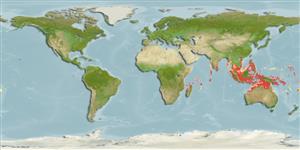>
Tetraodontiformes (Puffers and filefishes) >
Ostraciidae (Boxfishes)
Etymology: Rhynchostracion: Greek, rhingchos = snout + Greek, ostrakon = a little shell (Ref. 45335).
More on author: Bloch.
Issue
Genus according to Matsuura (Ref. 9806).
Environment: milieu / climate zone / depth range / distribution range
Écologie
marin récifal; profondeur 2 - 80 m (Ref. 1602). Tropical; 19°N - 20°S
Western Pacific: Sri Lanka (Ref. 1550) and Sumatra to Fiji, north to the Philippines; Palau and Truk in Micronesia. Matsuura 1999, pers. comm. strongly doubts its distribution in the southern GBR (as reported in Lieske & Meyers 1994, Ref. 9710) and does not know of any reliable record of this species from East Africa.
Taille / Poids / Âge
Maturity: Lm ? range ? - ? cm
Max length : 30.0 cm TL mâle / non sexé; (Ref. 2334)
Description synthétique
Clés d'identification | Morphologie | Morphométrie
Épines dorsales (Total) : 0; Rayons mous dorsaux (Total) : 9; Épines anales: 0; Rayons mous anaux: 9. Has a small protuberance above the mouth and a distinctly concave snout profile.
Found around rocky and sandy substrates (Ref. 1602). Solitary, also found in sheltered bays exposed to heavy silt and mud bottoms of coastal trawling grounds (Ref. 90102).
Life cycle and mating behavior
Maturité | Reproduction | Frai | Œufs | Fécondité | Larves
Matsuura, K., 2001. Ostraciidae. Boxfishes. p. 3948-3951. In K.E. Carpenter and V. Niem (eds.) FAO species identification guide for fishery purposes. The living marine resources of the Western Central Pacific. Vol. 6. Bony fishes part 4 (Labridae to Latimeriidae), estuarine crocodiles. FAO, Rome. (Ref. 9806)
Statut dans la liste rouge de l'IUCN (Ref. 130435: Version 2024-1)
Menace pour l'homme
Venomous
Utilisations par l'homme
Outils
Articles particuliers
Télécharger en XML
Sources Internet
Estimates based on models
Preferred temperature (Ref.
123201): 26.7 - 29, mean 28.2 °C (based on 1104 cells).
Phylogenetic diversity index (Ref.
82804): PD
50 = 1.0000 [Uniqueness, from 0.5 = low to 2.0 = high].
Bayesian length-weight: a=0.03548 (0.01723 - 0.07305), b=2.81 (2.62 - 3.00), in cm total length, based on LWR estimates for this (Sub)family-body shape (Ref.
93245).
Niveau trophique (Ref.
69278): 3.2 ±0.2 se; based on size and trophs of closest relatives
Résilience (Ref.
120179): Haut, temps minimum de doublement de population inférieur à 15 mois (Fec assumed to be > 10,000).
Fishing Vulnerability (Ref.
59153): Low vulnerability (20 of 100).
Nutrients (Ref.
124155): Calcium = 47.6 [20.5, 105.6] mg/100g; Iron = 0.655 [0.340, 1.443] mg/100g; Protein = 18.1 [15.8, 20.2] %; Omega3 = 0.113 [0.057, 0.215] g/100g; Selenium = 41.8 [21.8, 87.6] μg/100g; VitaminA = 48 [13, 176] μg/100g; Zinc = 1.23 [0.83, 1.81] mg/100g (wet weight);
